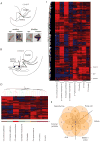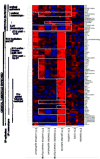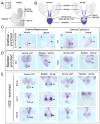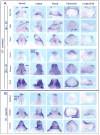Comparative gene expression analysis of genital tubercle development reveals a putative appendicular Wnt7 network for the epidermal differentiation
- PMID: 20510229
- PMCID: PMC3154616
- DOI: 10.1016/j.ydbio.2010.05.495
Comparative gene expression analysis of genital tubercle development reveals a putative appendicular Wnt7 network for the epidermal differentiation
Abstract
Here we describe the first detailed catalog of gene expression in the developing lower urinary tract (LUT), including epithelial and mesenchymal portions of the developing bladder, urogenital sinus, urethra, and genital tubercle (GT) at E13 and E14. Top compartment-specific genes implicated by the microarray data were validated using whole-mount in situ hybridization (ISH) over the entire LUT. To demonstrate the potential of this resource to implicate developmentally critical features, we focused on gene expression patterns and pathways in the sexually indeterminate, androgen-independent GT. GT expression patterns reinforced the proposed similarities between development of GT, limb, and craniofacial prominences. Comparison of spatial expression patterns predicted a network of Wnt7a-associated GT-enriched epithelial genes, including Gjb2, Dsc3, Krt5, and Sostdc1. Known from other contexts, these genes are associated with normal epidermal differentiation, with disruptions in Dsc3 and Gjb2 showing palmo-plantar keratoderma in the limb. We propose that this gene network contributes to normal foreskin, scrotum, and labial development. As several of these genes are known to be regulated by, or contain cis elements responsive to retinoic acid, estrogen, or androgen, this implicates this pathway in the later androgen-dependent development of the GT.
Copyright 2010 Elsevier Inc. All rights reserved.
Figures







Similar articles
-
Regulatory roles of epithelial-mesenchymal interaction (EMI) during early and androgen dependent external genitalia development.Differentiation. 2019 Nov-Dec;110:29-35. doi: 10.1016/j.diff.2019.08.004. Epub 2019 Sep 11. Differentiation. 2019. PMID: 31590136 Review.
-
A high throughput in situ hybridization method to characterize mRNA expression patterns in the fetal mouse lower urogenital tract.J Vis Exp. 2011 Aug 19;(54):2912. doi: 10.3791/2912. J Vis Exp. 2011. PMID: 21876526 Free PMC article.
-
Tissue-specific roles of FGF signaling in external genitalia development.Dev Dyn. 2015 Jun;244(6):759-73. doi: 10.1002/dvdy.24277. Dev Dyn. 2015. PMID: 25820239
-
An illustrated anatomical ontology of the developing mouse lower urogenital tract.Development. 2015 May 15;142(10):1893-908. doi: 10.1242/dev.117903. Epub 2015 May 12. Development. 2015. PMID: 25968320 Free PMC article.
-
Molecular genetic cascades for external genitalia formation: an emerging organogenesis program.Dev Dyn. 2006 Jul;235(7):1738-52. doi: 10.1002/dvdy.20807. Dev Dyn. 2006. PMID: 16598715 Review.
Cited by
-
Molecular Characterization of the Genital Organizer: Gene Expression Profile of the Mouse Urethral Plate Epithelium.J Urol. 2016 Oct;196(4):1295-302. doi: 10.1016/j.juro.2016.04.091. Epub 2016 May 9. J Urol. 2016. PMID: 27173853 Free PMC article.
-
Grhl2 determines the epithelial phenotype of breast cancers and promotes tumor progression.PLoS One. 2012;7(12):e50781. doi: 10.1371/journal.pone.0050781. Epub 2012 Dec 17. PLoS One. 2012. PMID: 23284647 Free PMC article.
-
One Tool for Many Jobs: Divergent and Conserved Actions of Androgen Signaling in Male Internal Reproductive Tract and External Genitalia.Front Endocrinol (Lausanne). 2022 Jun 30;13:910964. doi: 10.3389/fendo.2022.910964. eCollection 2022. Front Endocrinol (Lausanne). 2022. PMID: 35846302 Free PMC article. Review.
-
Cell-specific alterations in Pitx1 regulatory landscape activation caused by the loss of a single enhancer.Nat Commun. 2021 Dec 13;12(1):7235. doi: 10.1038/s41467-021-27492-1. Nat Commun. 2021. PMID: 34903763 Free PMC article.
-
Genome-wide association analyses identify variants in developmental genes associated with hypospadias.Nat Genet. 2014 Sep;46(9):957-63. doi: 10.1038/ng.3063. Epub 2014 Aug 10. Nat Genet. 2014. PMID: 25108383
References
-
- Adamska M, MacDonald BT, Meisler MH. Doubleridge, a mouse mutant with defective compaction of the apical ectodermal ridge and normal dorsal-ventral patterning of the limb. Dev Biol. 2003;255:350–362. - PubMed
-
- Ahn K, Mishina Y, Hanks MC, Behringer RR, Crenshaw EB., III BMPR-1A signaling is required for the formation of the apical ectodermal ridge and dorsal-ventral patterning of the limb. Development. 2001;128:4449–4451. - PubMed
-
- Al-Qattan MM, Al-Balwi M, Eyaid W, Al-Abdulkarim I, Al-Turki S. Congenital duplication of the palm syndrome: gene analysis and the molecular basis of its clinical features. J Hand Surgery. 2009;34E:247–251. - PubMed
-
- Beleza-Meireles A, Lundberg F, Lagerstedt K, Zhou X, Omrani D, Frisen L, Norddenskjold A. FGFR2, FGF8, FGF10 and BMP7 as candidate genes for hypospadias. Eur J Hum Genetics. 2007;15:405–410. - PubMed
Publication types
MeSH terms
Substances
Grants and funding
LinkOut - more resources
Full Text Sources
Other Literature Sources
Molecular Biology Databases
Research Materials
Miscellaneous

